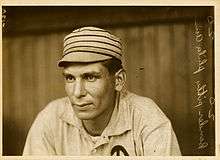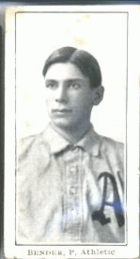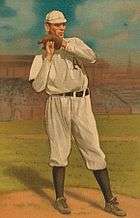Chief Bender
Charles Albert "Chief" Bender (May 5, 1884[a 1] – May 22, 1954) was a pitcher in Major League Baseball during the 1910s and 1920s. In 1911, Bender tied a record by pitching three complete games in a single World Series. He finished his career with a 212–127 win-loss record for a .625 winning percentage and a career 2.46 earned run average (ERA).
| Chief Bender | |||
|---|---|---|---|
 Chief Bender in 1911 | |||
| Pitcher | |||
| Born: May 5, 1884 Crow Wing County, Minnesota | |||
| Died: May 22, 1954 (aged 70) Philadelphia, Pennsylvania | |||
| |||
| MLB debut | |||
| April 20, 1903, for the Philadelphia Athletics | |||
| Last MLB appearance | |||
| July 21, 1925, for the Chicago White Sox | |||
| MLB statistics | |||
| Win–loss record | 212–127 | ||
| Earned run average | 2.46 | ||
| Strikeouts | 1,711 | ||
| Teams | |||
| Career highlights and awards | |||
| |||
| Member of the National | |||
| Induction | 1953 | ||
| Election Method | Veterans Committee | ||
After his major league playing career, Bender filled multiple baseball roles, including service as a major league coach, minor league manager and player-manager, college manager and professional scout. He was elected to the Baseball Hall of Fame in 1953 and he died not long before his induction ceremony the following year.
Early life
Bender was born in Crow Wing County, Minnesota, as a member of the Ojibwe tribe. His father was German and his mother was part Chippewa. As a child, he was given the Ojibwe language name "Mandowescence", meaning "Little Spirit Animal". His family had 160 acres (65 ha) on the White Earth Indian Reservation near Bemidji, Minnesota. His father taught him to farm on the reservation.[1] He graduated from Carlisle Indian Industrial School and attended Dickinson College.
Baseball career


Early career
Bender debuted in the major leagues in 1903. He is one of only a few pitchers in the 20th century to throw 200 or more innings at the age of 19. His walks per nine innings rate was 2.17; only a few pitchers since 1893 have had a rate below 2.2 at the age of 20 or younger. That year, he also won a game against Cy Young and met his future wife Marie.[2]
In 1905, Bender earned an 18–11 win-loss record with a 2.83 ERA, helping the A's win the AL pennant; but they lost the World Series in five games to the New York Giants. Bender went 1–1, 1.06 ERA in the series, pitching a 4-hit, 3–0 complete game shutout in Game 2, striking out 9, and again went the distance in Game 5, giving up just two earned runs in eight innings and losing 2–0 to Christy Mathewson.
After solid seasons in 1906 (15–10, 2.53), 1907 (16–8, 2.05), 1908 (8–9 despite a 1.75 ERA, and 1909 (18–8, 1.66), he led the Athletics to the AL pennant in 1910, as Philadelphia went 102–48, 14½ games ahead of the second-place New York Yankees. Bender led the AL in winning percentage, at .821, going 23–5 with a 1.58 ERA. He went 1–1 with a 1.93 ERA in the World Series as the A's beat the Chicago Cubs, who had gone 104–50 in the regular season, in five games. Bender pitched a complete-game three-hitter in the opener, striking out 8 and giving up only one unearned run. He lost Game 4 of the series in another complete game effort, 4–3 in 10 innings. Bender pitched all 9⅔ innings for the Athletics, striking out 6.
Later career
_(1911)_(14801801473).jpg)
In 1911, he led the AL in winning percentage again (.773), going 17–5 with a 2.16 ERA as the A's won their second consecutive AL pennant, going 101–50 and finishing 13½ games ahead of the Detroit Tigers. In a rematch of the 1905 World Series, the Athletics got their revenge, defeating the New York Giants and becoming the first American League team to win back-to-back World Series (the Chicago Cubs from the NL had won back-to-back titles in 1907 and 1908). After losing the opener 2–1 to Christy Mathewson, though pitching a complete game, giving up just 5 hits and 2 runs (1 earned run) and striking out 11, he returned in Game 4, beating the Giants 4–2 on a complete game 7-hitter, and closed out the Series in game 6 with a 13–2 A's victory. Bender again went the distance (his 3rd complete game of the series), a 4-hit performance which he gave up no earned runs (the two Giants runs were unearned). He went 2–1, with 1.04 ERA and 3 complete games in the series.
In 1912 Bender was 13–8 with a 2.74 ERA. He did not start for nearly 40 games late in the year and was suspended by the A's in September for alcohol abuse. His next contract had a clause saying he had to abstain from drinking to earn his full salary. In 1913, he went 21–10 with a 2.21 ERA, helping the A's win their third AL pennant in four years. They would also make it three World Series titles in four years by defeating the Giants in five games. Bender went 2–0 in the series with complete-game victories in Games 1 and 4.
He led the AL in winning percentage (.850) for the third time in 1914, going 17–3 with a 2.26 ERA, and the A's would win their fourth AL pennant in five years. But the Philadelphia Athletics would be swept by the underdog Boston Braves, with Bender losing Game 1 7–1 and giving up 6 earned runs in 5⅓ innings. It was the only World Series game he failed to finish, after completing his previous nine starts in the Fall Classic.
When the Baltimore Terrapins of the upstart Federal League offered Bender a significant increase in salary, Athletics manager Connie Mack knew he could not hope to match it and released him. Bender went 4–16 for the Terrapins and later regretted leaving Philadelphia. After two years with the Phillies, he left baseball in 1918 to work in the shipyards during World War I.
Over his career, his win-loss record was 212–127, for a .625 winning percentage (a category in which he led the American League in three seasons), and a career 2.46 ERA. His talent was even more noticeable in the high-pressure environment of the World Series; in five trips to the championship series, he managed six wins and a 2.44 ERA, completing 9 of the 10 games he started, putting him 2nd in World Series history behind Christy Mathewson. In the 1911 Series, he pitched three complete games to tie Christy Mathewson's record of three complete games in a World Series. He also threw a no-hitter on May 12, 1910, beating the Cleveland Indians 4–0.
Bender was a very adept hitting pitcher in his major league career, posting a .212 batting average (243-for-1,147) with 102 runs, 6 home runs and 116 RBI. He had 10 or more RBI in a season four times, with a career high 16 in 1910.
Minor leagues
In 1919, Bender pitched in the minor leagues for the Richmond Colts of the Virginia League. He earned a 29–2 record that year. He spent the next three seasons as a player-manager; the first two seasons were with the New Haven Weissmen/Indians, and the third was with the Class AA Reading Aces. For the 1920 New Haven team, Bender recorded 25 wins as a pitcher. His record declined to 13–7 in 1921 and 8–13 in 1922.[4]
In 1923 and 1924, Bender did not manage, but did pitch for the minor league Baltimore Orioles and the New Haven Profs, respectively. He went 6–3 with a 5.03 ERA for Baltimore, then went 6–4 with a 3.07 ERA for New Haven.[4]
Coaching career
He came back to the majors as a coach for the Chicago White Sox (1925–26) and even made a cameo appearance on the mound in 1925. Between 1924 and 1928, Bender managed the baseball team at the United States Naval Academy.[5] He recorded a 42–34–2 record for the Naval Academy.[6] In 1931, he coached for the Giants and the next year managed the Yankee affiliate in the Central League. He then returned to the Athletics where he worked the rest of his life as a scout, minor league manager, and coach.
Personal
Bender was nicknamed "Chief", a common nickname for baseball players of Native American descent.[7] Biographer Tom Swift writes that Bender "was often portrayed as a caricature and was the subject of myriad cartoons – many exhibits of narrow-mindedness. After he threw one of the most dominating games of the early years of the American League, Bender was depicted wielding a tomahawk and wearing a headdress as though he was a happy warrior."[8]
He also faced discrimination on the field. Swift writes that taunting from the bench was common in Bender's era and that the opposition or the fans often made war whoops or yelled taunts such as "Nig!" or "Back to the reservation!" Bender usually remained calm, sometimes smiling at the insults. After an inning in which he had pitched particularly well, he might yell back, "Foreigners! Foreigners!"[9]
Off the baseball field, Bender was one of several prominent baseball players who enjoyed trap shooting, bowling and golf.[10][11] He felt that shooting in the offseason helped to train his eye and increase his self-control. He worked in sporting goods at Wanamaker's in Philadelphia during his early playing days.[12] He opened his own store, Bender Sporting Goods, in 1914.[13]
Bender's brother, John C. Bender, also played professional baseball. John Bender was suspended from minor league baseball for three years beginning in 1908 after he stabbed his manager, Win Clark, several times during a fight. John Bender is sometimes erroneously described as having died on a baseball field, but he died at a restaurant in 1911, not long after attempting a professional baseball comeback.[14]
Later life
Late in his life, Bender's friend John Burns gave him a plot of land in Haddon Heights, New Jersey. Bender planted a garden on the land and worked with it almost every day, even though he lived in Philadelphia. He grew a number of fruits and vegetables, especially corn, and either ate, sold or gave away what he grew.[15] After the 1950 season, Bender took his last position in the major leagues, replacing Mickey Cochrane as the pitching coach for the Athletics.[16] Bender's coaching helped pitcher Bobby Shantz to the American League Most Valuable Player Award in 1952.[17] Bender was struggling with health problems, including arthritis and a cancer he did not disclose, during his tenure with Philadelphia.[18]
In his last days, Bender remained close friends with Athletics coach Bing Miller, who used to bring Bender a container of ice cream almost every day. Bender was hospitalized in Philadelphia in mid-April 1954. He died there on May 22, 1954, of prostate cancer. He had also been suffering from cardiac problems.[19] While he had been hospitalized, Bender sent Marie to Shibe Park for each home game so that she could report back to him on his team's pitching.
Bender was buried in the Philadelphia suburb of Roslyn, Pennsylvania.[20]
Legacy
Bender was well-liked by his fellow players. Long-time roommate and fellow pitcher Rube Bressler called him "one of the kindest and finest men who ever lived".[21] Ty Cobb praised his intelligence, describing a play by Bender in the 1911 World Series as "the greatest bit of brainwork I ever saw in a ballgame".[22] Cobb was not alone in regard for his intelligence; Bender drew similar praise from many other teammates, opponents, and umpires, including Billy Evans and Nap Lajoie.[23] Bender was also known for his keen eyes and ability to discern subtle details of opposing pitchers' motions to help his teammates predict their pitches.[24] His success led other teams to suspect Bender and the Athletics were stealing signs; though teammate Cy Morgan denied the A's were stealing signs, Danny Murphy praised Bender's ability and said he could "come pretty near to getting anybody's signs". Mack often put this skill to use by occasionally using him as the third base coach or first base coach on days he wasn't scheduled to pitch.[25]
The innovator of the slider is debated, but some credit Bender as the first to use the pitch, then called a "nickel curve", in the 1910s.[26] Bender used his slider to help him achieve a no-hitter and win 212 games.[27]
Bender was voted into the Baseball Hall of Fame in 1953, less than a year before his death. He died before his induction ceremony and Marie accepted the Hall of Fame plaque on his behalf.[20]
In 1981, Lawrence Ritter and Donald Honig included him in their book The 100 Greatest Baseball Players of All Time.
See also
Notes
- There is uncertainty about Bender's birth-date. He was voted the SABR "Centennial Celebrity" of 1983, as the best baseball player or figure born in 1883. However, the SABR Baseball Research Journal for 1983 acknowledges that there are discrepancies in records about Bender's birth year, ranging from 1883 to 1885. 1884 is the figure most often given.
Citations
- Kashatus, pp. 5-6
- Swift, p. 108
- "The Baseball Bug". Thanhouser Company Film Preservation, Inc. Archived from the original on 2017-01-07. Retrieved 2016-01-22.
- "Chief Bender Minor League Statistics & History". Baseball-Reference.com. Retrieved July 6, 2014.
- 2014 Baseball Media Guide (PDF). United States Naval Academy. p. 51.
- 2014 Baseball Media Guide (PDF). United States Naval Academy. p. 46.
- Swift, p. 4
- Swift, p. 5
- Swift, p. 6
- Kaufman, King. "Chief Bender's Burden (review)". Salon.com. Retrieved November 1, 2014.
- "Big Chief Bender trap-shooting star". The Day (New London). March 2, 1915. Retrieved November 1, 2014.
- Kashatus, p. 140
- "Chief Bender is going into business". Dawson Daily News. June 1, 1914. Retrieved November 1, 2014.
- Gorman, Robert, Weeks, David (2009). Death at the Ballpark: A Comprehensive Study of Game-related Fatalities of Players, Other Personnel and Spectators in Amateur and Professional Baseball, 1862–2007. McFarland. p. 102. ISBN 0786452544. Retrieved July 5, 2014.
- Swift, pp. 281-282
- Kashatus, p. 146
- Kashatus, p. 148
- Kashatus, p. 149
- Swift, p. 285
- Kashatus, p. 152
- Ritter, Lawrence (1966). The Glory of Their Times. p. 199.
- Swift, p. 162
- Swift, Tom (April 30, 2005). "Chief Bender". Society for American Baseball Research. Archived from the original on July 26, 2019. Retrieved July 25, 2019.
- Sanborn, L. E. (April 6, 2019). "Chief Bender's Keen Eyes Athletics' Signal Detector". Sporting Life. Retrieved July 25, 2019.
- Swift, pp. 187-191
- "WISCONSIN Magazine of History",Wisconsin Historical Society Press, Spring 2004 issue. Accessed July 8, 2007.
- "National Baseball Hall of Fame and Museum: Hall of Famer detail" Archived May 25, 2009, at the Wayback Machine,National Baseball Hall of Fame. Accessed July 8, 2007.
References
- Kashatus, William C. (2006). Money Pitcher: Chief Bender and the Tragedy of Indian Assimilation. Penn State Press. ISBN 978-0-271-02862-0.
- Swift, Tom (2008), Chief Bender's Burden: The Silent Struggle of a Baseball Star, University of Nebraska Press
Further reading
- Powers-Beck, Jeffrey P. (2004). The American Indian integration of baseball. University of Nebraska Press. pp. 269. ISBN 978-0-8032-3745-2.
External links
| Wikimedia Commons has media related to Charles Albert Bender. |
- Career statistics and player information from Baseball-Reference, or Fangraphs
- The Deadball Era
- Chief Bender at Find a Grave

- Charles Albert Bender at MNopedia.
| Preceded by Addie Joss |
No-hitter pitcher May 12, 1910 |
Succeeded by Smoky Joe Wood |
